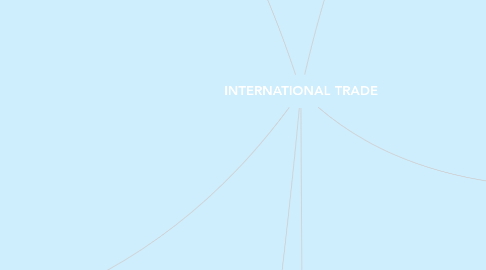
1. Comparative advantage
1.1. A country has a comparative advantage when the cost of produce a good, with respect to the other goods produced by the same country, are minor.
1.2. It is the ability to produce a good using relatively fewer resources than another. It is one of the basic foundations of the trade between countries.
1.3. Example
1.3.1. countries
1.3.1.1. computers
1.3.1.2. coffee
1.4. Spread by
1.5. David Ricardo
1.6. It is characterized by
1.7. Specialization
1.8. At
1.9. Production of a good with a disadvantage
1.10. This is achieved by
1.10.1. Mutual exchange
1.10.2. Comparative advantage
2. What are the obstacles or promoters that prevent participation in global value chains? GVC
2.1. On entry, ownership and operations, and procedures
2.2. Duplicate production processes
2.3. Burdensome certification procedures several times for the same product
2.4. Increasing number of quality and safety standards
2.5. Example
2.5.1. Elevated eyebrows.
2.6. Border measures affect the timeliness and cost with which firms can access inputs from abroad and export products.
3. Absolute advantage
3.1. Theory of work value
3.1.1. The wealth of a country is generated by the advantage of internal production and its labor force.
3.1.2. The specialization of production generates efficiency and reduces the use of resources.
3.1.3. When a country specializes in resources and production that is more efficient and productive.
3.1.4. Countries exchange goods and obtain more product for their inhabitants, thus improving internal consumption.
3.2. Disseminated by
3.2.1. Adam Smith
3.2.1.1. It is catered for by
3.2.1.1.1. Specialization
4. Factor proportion teory
4.1. International differences in production costs.
4.1.1. Differences in the source of production factors.
4.1.2. capital y trabajo.
4.1.3. The technology that determines how both are combined to form an asset.
4.1.4. They export goods produced with the intensive use of production factors in abundance.
4.2. Differences in the production costs of a good; the more abundant a factor, the cheaper it is to produce a good.
5. Ventaja competitiva (diamante de Porter)
5.1. Government
5.1.1. Structure
5.1.2. Strategy
5.1.3. Business Rivalry
5.1.4. Conditions of the demand
5.1.5. Related and Supporting Sectors
5.1.6. Factor conditions
6. Trade policy
6.1. Actions and measures to regulate trade.
6.1.1. It improves the distribution of income and living standards in the population.
6.1.2. Strengthening in the internal market
6.1.3. Fulfillment of international commitments.
6.1.4. productive capacity
6.1.5. Diversifies
6.1.6. Strengthening
6.1.6.1. The competitiveness
6.1.6.2. The technological change
6.1.6.3. Employment levels
6.2. Instruments
6.2.1. Productive Transformation
6.2.2. Financial
6.2.3. Foments and stabilization
6.2.4. Access to markets
6.2.5. Tax and Customs
6.3. Actions Like
6.3.1. Import Fees
6.3.2. Grants
6.3.2.1. Imports
6.3.2.2. Exports
6.3.3. Tariffs
6.4. General aspects
6.4.1. maximize
6.4.2. Attract
6.4.3. Diversify
6.4.4. Achieve
6.5. Free trade agreements.
6.5.1. Supporting and regulating
6.5.1.1. Exports
6.5.1.2. Imports
